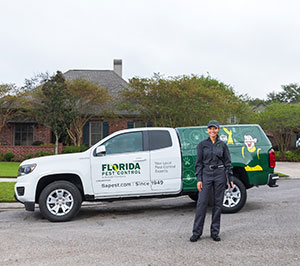A1 Charlotte Pest Control Companies - Your Neighborhood Pest Specialists
A1 Charlotte Pest Control Companies - Your Neighborhood Pest Specialists
Blog Article
Bed Bug Therapy Break Down: Contrasting Chemical Vs. Non-Chemical Solutions
In the realm of bug control, particularly when managing the consistent concern of bed bugs, the choice in between chemical and non-chemical treatment options can be an essential one. Both techniques use unique benefits and disadvantages, influencing aspects such as effectiveness, security factors to consider, and overall expense. By examining the nuanced details of each approach, a clearer understanding of which path to go after in resolving a bed insect invasion can be attained.
Efficiency of Chemical Treatments
Chemical treatments for bed insect invasions have been extensively recognized for their powerful and fast efficacy in eliminating these pests. When considering the performance of chemical therapies, it is important to comprehend that they can offer a quick and detailed service to a bed bug problem.
In addition, chemical treatments have the benefit of offering residual results, indicating that they can remain to remove bed insects also after the preliminary application. This recurring activity is particularly advantageous in combating any type of possible re-infestations. Additionally, the quick action of chemical therapies can bring relief to people dealing with extreme bed insect problems, enabling them to restore control of their home swiftly.
Security Interest In Chemical Solutions
When using chemical remedies for bed insect therapy is ensuring the safety of passengers and the environment,One important facet that calls for careful factor to consider. While chemical treatments can be effective in removing bed bugs, they may pose risks otherwise handled correctly. Among the key safety worry about chemical options is the potential injury they can create to human wellness. Exposure to particular chemicals made use of in bed pest therapies can lead to breathing issues, skin inflammation, or other adverse responses, particularly in people with pre-existing conditions or level of sensitivities. In addition, inappropriate application or dose of chemical pesticides can cause toxic residues lingering in the cured area, positioning long-lasting wellness risks to passengers.
Additionally, the ecological effect of chemical remedies is another significant consideration. Some chemicals made use of in bed insect therapies may be damaging to advantageous pests, wildlife, and ecological communities if they leach right into the soil or water supply. It is important to use chemical therapies sensibly, adhering to safety and security standards, and taking into consideration less toxic choices to alleviate these dangers and ensure the risk-free and effective monitoring of bed pest invasions.
Advantages of Non-Chemical Approaches
Thinking about the potential security problems and ecological impact connected with chemical remedies for bed pest therapy, exploring non-chemical techniques presents an encouraging option with numerous unique benefits. Non-chemical methods offer a safer alternative for households, specifically those with kids, animals, or individuals conscious rough chemicals. These techniques eliminate the risks of direct exposure to poisonous substances, lowering the potential for negative health impacts. Furthermore, non-chemical therapies are eco friendly, as they do not add to air or water pollution, making them a sustainable selection for parasite control.
In addition, non-chemical solutions can be efficient in targeting bed pests, consisting of hard-to-reach locations where chemical treatments may not permeate - A1 charlotte pest control companies. Methods such as warm therapy, vacuuming, steam cleansing, and cushion encasements give extensive obliteration without the use of dangerous chemicals.
Limitations of Non-Chemical Treatments

Furthermore, non-chemical treatments frequently call for several applications to accomplish effective obliteration. This can be time-consuming and may not constantly guarantee complete elimination of all bed bugs and their eggs, specifically in surprise or hard-to-reach places.
In addition, the success of non-chemical treatments heavily relies on correct application and thoroughness, which can be testing for individuals without professional knowledge. Inadequate application of non-chemical approaches might result in incomplete elimination, resulting in consistent infestations and the demand for additional treatments.
For that reason, while non-chemical therapies have their benefits, it is vital to acknowledge these limitations and consider them when figuring out one of the most effective method for taking care of bed bug invasions.
Price Contrast: Chemical Vs. Non-Chemical Options
Offered the restrictions linked with non-chemical therapies, a crucial element to review in the context of bed insect monitoring is the expense contrast between chemical and non-chemical alternatives. In comparison, non-chemical treatments like warmth therapy or steam can be a lot more costly, with prices varying from $1,000 to $6,000 for an entire home. While the initial cost of chemical therapies might straight from the source seem lower, numerous therapies might be called for to totally eradicate the infestation, potentially enhancing the general price.
Conclusion

Thinking about the possible safety worries and environmental effect linked with chemical services for bed bug therapy, exploring non-chemical techniques presents an encouraging choice with several distinct advantages.Offered the limitations linked with non-chemical therapies, a crucial element to review in the context of bed insect monitoring is the cost contrast in between chemical and non-chemical options. In comparison, non-chemical therapies like warm therapy or heavy steam can be more pricey, with prices varying from $1,000 to $6,000 for a whole home. While the first cost of chemical treatments may appear lower, numerous therapies may be needed to totally get rid of the infestation, possibly enhancing the total expense.In conclusion, when comparing chemical advice and non-chemical bed pest therapy alternatives, it is important to think about performance, safety, advantages, limitations, and cost.
Report this page